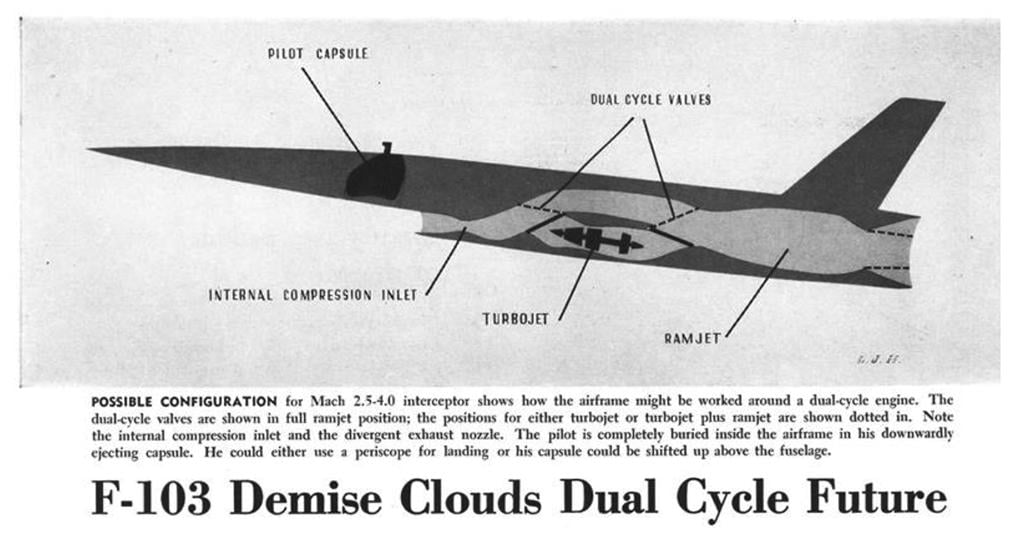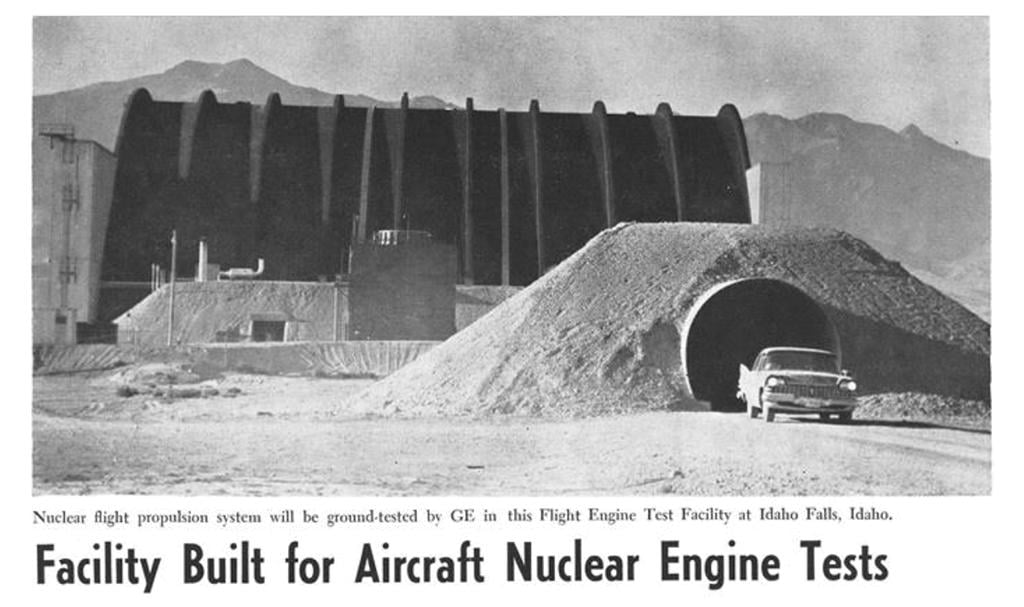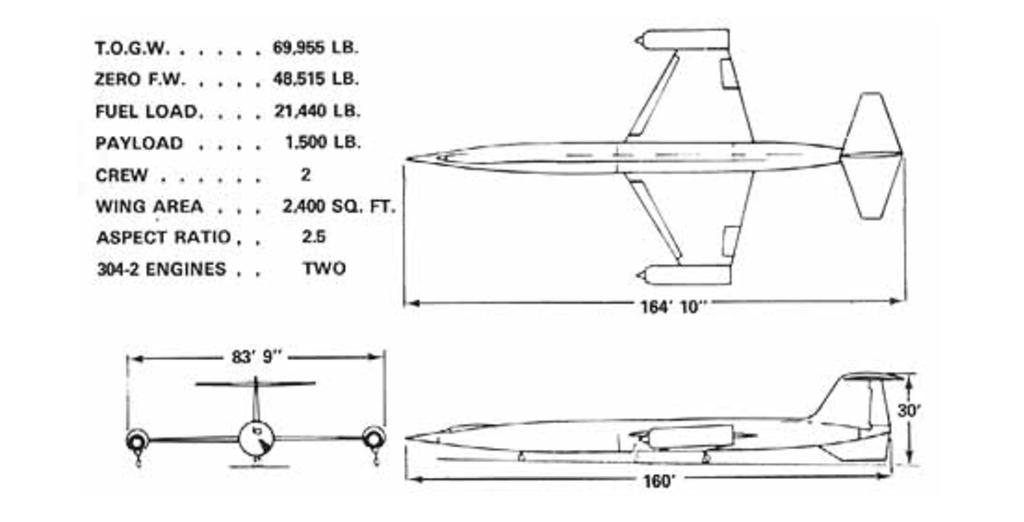
XF-103
In 1948, the MX-1554 design competition produced bids for a new U.S. Air Force high-speed interceptor. The Air Force selected the Convair F-102 Dart, which entered production following an area-ruling-inspired redesign. But another design intrigued the Air Force enough to win a long-term development deal as well. This was Republic’s awesomely ambitious XF-103. Imagine a single-pilot fighter that could accelerate to over Mach 2 on turbojet thrust. At some point between Mach 2-3, the airflow would divert to a ramjet to accelerate up to Mach 4. The project would be ambitious in 2022, much less the late 1940s. In addition to the still-unconquered propulsion challenge, Republic’s engineers struggled to cope with the high stagnation temperatures at Mach 4. The cockpit was designed with a periscope for the pilot to see, since no transparent materials for windows could endure such heat. Republic’s engineers considered raising the cockpit seat during takeoff and landing, poking the pilot’s head above the fuselage and into the slipstream for a clear view of the runway. The program was canceled after nine years, before the XF-103 was ready for flight tests, despite promising results from dual-cycle engine testing in a wind tunnel (AW&ST Sept. 9, 1957, p. 101).

YF-12
An entry in Kelly Johnson’s project logbook for March 16-17, 1960, was hopeful. The founder of the Lockheed Skunk Works had been working on the A-12 spy plane for the CIA for more than six months, and he was already pitching the aircraft to the U.S. Air Force as a Mach 3 fighter interceptor. “Went to Washington to discuss A-12 as an air defense fighter to replace the F-108,” Johnson wrote in his logbook. “They said there would not be an immediate order, but that they were interested in getting development aspects of the fighter system carried along.” Ultimately, the Air Force would buy only three prototypes of the YF-12, which achieved a first flight in August 1963. Johnson hoped to build hundreds of YF-12s for the Air Force, replacing the F-106 with an interceptor more than half as fast. But a feared, Mach 3 Soviet bomber never materialized, depriving the YF-12 of a necessary threat to address. The Air Force transferred the YF-12s to NASA, which used the aircraft for high-speed research. Instead of supplying hundreds of Mach 3 interceptors, Lockheed settled for supplying dozens of related SR-71 spy planes to the Air Force (AW&ST Aug. 3, 1964, p. 16).

X-20
It was 1960: Three years after the first orbit of the Soviet Union’s Sputnik satellite and one year before that of cosmonaut Yuri Gagarin. The conventions establishing the peaceful usage of space were still years away. With Soviet satellites and capsules freely passing hundreds of miles above the U.S. every day, the U.S. Air Force wanted a space interceptor. Enter the Boeing X-20 Dynamic Soaring (Dyna-Soar) program (AW&ST Oct. 1, 1962, p. 25). As conceived, a Titan III booster would release the high-lift-to-drag X-20 into an orbital trajectory. The X-20 pilot could then shoot down another spacecraft or perhaps reenter the atmosphere to drop a bomb deep into Soviet territory before gliding to a landing in friendly territory thousands of miles away. The Dyna-Soar was in effect a fighter-bomber version of the high-lift-to-drag-ratio boost-glide missiles in development today, such as the Lockheed Martin AGM-183A Air-Launched Rapid Response Weapon. The Kennedy administration, however, decided to invest in NASA’s reentry vehicles, such as Gemini and Apollo, leading to the cancellation of the military X-20 program in 1963. Six decades later, the X-20 concept has since migrated to the commercial space industry. The design of the Sierra Space Dream Chaser is modeled on NASA’s HL-20 lifting body, a direct descendant of the X-20 program.

Aircraft Nuclear Propulsion
If nuclear reactors could power the U.S. Navy’s aircraft carriers and submarines, why could the energy yielded from splitting an atom not be harnessed for Air Force bombers and tankers? That was the logic behind a 14-year, $1 billion quest to invent Aircraft Nuclear Propulsion (ANP) that ended in 1961 (AW&ST Sept. 12, 1960, p. 135). The project sought to tackle the challenges of designing a nuclear reactor small and light enough to fit onboard a modified Convair B-36, along with the radioactive shielding required to protect the crew. A little-known side project of the ANP program tasked Lockheed’s Skunk Works with designing a nuclear-powered fighter, but their engineers gave up after concluding that the necessary shielding would require the cockpit to weigh 40,000 lb. In the end, GE managed to conquer some of the technical questions by flying a working reactor on a B-36—albeit disconnected from the propulsion system. In many ways, the J87 operated like a normal jet engine, except the nuclear reactor, rather than a combustor, heated the compressed air. This heated, radioactive air was channeled into the turbine section and then exhausted. Although technological challenges remained, social concerns about flying nuclear reactors and their radioactive exhaust doomed the program.

B-70
In the late 1950s, the competition between humans and automation came to war machines. At stake was which side—piloted bombers or intercontinental ballistic missiles (ICBM)—would be chosen to deliver nuclear warheads on targets in a first-strike attack upon the Soviet Union. The ICBMs, of course, won, although the Air Force continues to maintain the airborne leg of the Nuclear Triad as a retaliation option. But that had not yet been decided in 1957, when the subsonic Boeing B-52B was in service and the Mach 2-capable Convair B-58 was in development. To keep bombers competitive with ICBMs, the Air Force decided that something much faster than a B-58 was necessary. To meet the requirement, North American Aviation proposed a design that could reach Mach 3 by riding on its own supersonic shockwave. The XB-70 Valkyrie resembled nothing that came before or since (AW&ST May 18, 1964, p. 26). If ICBMs had not proved so effective and reliable by the early 1960s, the Valkyrie may have been the only option for providing a plausible nuclear deterrent. The first of two prototypes flew in 1964 and both reached Mach 3 by the end of the next year. But the Defense Department’s leadership had already decided that only ICBMs were necessary for the first-strike deterrence mission and slower bombers than the B-70 were sufficient for a retaliatory strike. A collision between one XB-70 prototype and an NF-104 chase plane during a 1966 photo opportunity only confirmed the program’s demise.

Suntan
It seemed like a great idea: Take 9.7 tons of the most efficient fuel source, liquid hydrogen, and fill up a Mach 2.5 aircraft capable of cruising at 90,000 ft. That could have helped solve one of the U.S. Air Force’s hardest problems in 1956: finding a way to fly over Soviet airspace without getting shot down. Air Force leaders were not satisfied with their role supporting CIA overflights using the subsonic Lockheed U-2 spyplane, an aircraft that had been rejected by the military before it was embraced by the civilian intelligence agency. So the Air Force commissioned the U-2’s designer—then-Lockheed Chief Engineer Clarence “Kelly” Johnson—to design an aircraft that could fly higher and faster. As the U-2 launched its first Soviet overflight on July 4, 1956, Johnson’s Skunk Works was already working on its potential replacement: the CL-400. Known as Project Suntan by the Air Force, work started in 1956 to build the first two prototypes of the hydrogen-fueled CL-400 and the Pratt & Whitney Model 304 jet engine. But Johnson’s optimism about the idea quickly faded. To produce the liquid-hydrogen fuel for the prototypes, Skunk Works needed to consume 10% of the available electricity on the Southern California power grid. Transporting and storing the highly combustible fuel all over the world posed another challenge. Finally, the cryogenic fuel tanks onboard the CL-400 could not be easily enlarged, limiting the potential range growth for the aircraft to about 3%. Johnson recommended that the project be terminated in 1957, and the Air Force agreed more than a year later.
The Defense Department spends billions of dollars placing bets on new technologies every year. This gallery explores some of the Air Force efforts that pushed the boundaries of physics. Some, such as the XF-103, reached so far it was canceled altogether. The design of other projects, such as the X-20, live on in the commercial space vehicles we see today.

Comments
This work took place at the purpose built, CANEL, facility in Middletown Conn. Which is today Pratts primary final engine assembly facility.
It launched an AIM-47 at 74,000ft and mach 3.2, and hit a target drone flying at 500 ft. Still impressive even today. This system led directly to the vaunted AN/AWG-9 in the F-14.